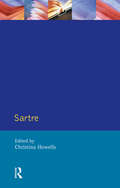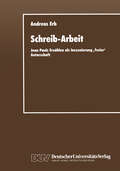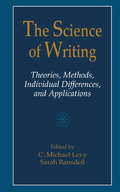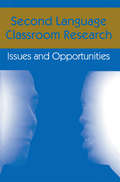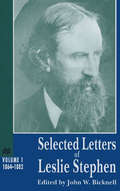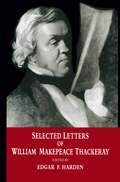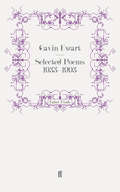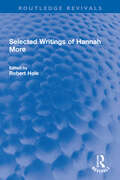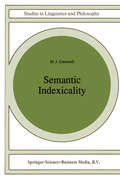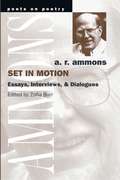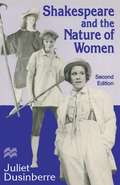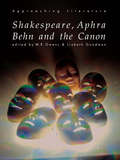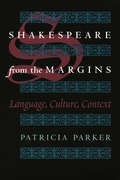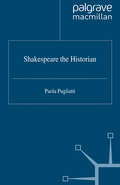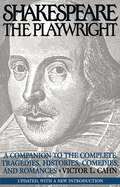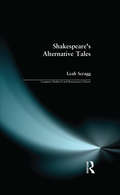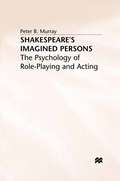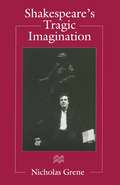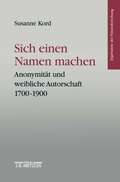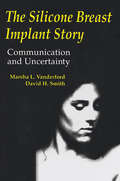- Table View
- List View
Sartre
by Christina HowellsFirst published in 1996. Routledge is an imprint of Taylor & Francis, an informa company.
The Science of Writing: Theories, Methods, Individual Differences and Applications
by C. Michael Levy Sarah RansdellConceived as the successor to Gregg and Steinberg's Cognitive Processes in Writing, this book takes a multidisciplinary approach to writing research. The authors describe their current thinking and data in such a way that readers in psychology, English, education, and linguistics will find it readable and stimulating. It should serve as a resource book of theory, tools and techniques, and applications that should stimulate and guide the field for the next decade. The chapters showcase approaches taken by active researchers in eight countries. Some of these researchers have published widely in their native language but little of their work has appeared in English-language publications.
The Science of Writing: Theories, Methods, Individual Differences and Applications
by C. Michael Levy Sarah RansdellConceived as the successor to Gregg and Steinberg's Cognitive Processes in Writing, this book takes a multidisciplinary approach to writing research. The authors describe their current thinking and data in such a way that readers in psychology, English, education, and linguistics will find it readable and stimulating. It should serve as a resource book of theory, tools and techniques, and applications that should stimulate and guide the field for the next decade. The chapters showcase approaches taken by active researchers in eight countries. Some of these researchers have published widely in their native language but little of their work has appeared in English-language publications.
Second Language Classroom Research: Issues and Opportunities (Second Language Acquisition Research Series)
by Jacquelyn Schachter Susan M. GassIn an attempt to fill the gap left by the many published studies on classroom second language research, this book explores a variety of human, social, and political issues involved in the carrying out of such studies. Many journals are chock-full of the results of classroom research, with evidence to support one claim or another about the efficacy of one teaching method or another. Many textbooks are replete with statistical procedures to be used, and with experimental designs to fit varying situations. Too often overlooked in these treatments are the human, social, and political issues involved in carrying out research in classrooms that are not one's own. What are the problems going to be when one attempts work such as this? What does one do on discovering that an administrator's agenda is different than one had thought? What does one do when a teacher resents intrusions into her classroom? This book offers a view on those kinds of issues, as presented and managed by successful classroom researchers themselves. The authors present their own experiences including, on occasion, their trials and tribulations and how they dealt with them. They lay themselves open to criticism in doing so, but they make their contributions much the richer as well. The classroom contexts extend to different countries, and range from elementary schools to universities. Some of the issues presented are: * the necessarily collaborative nature of the research; * the question of meshing pedagogically sound and experimentally acceptable practices; * the often strong possibility that political and social decisions will interrupt the research; * the perennial question of reporting out the results; and * the training of graduate student researchers.
Second Language Classroom Research: Issues and Opportunities (Second Language Acquisition Research Series)
by Jacquelyn Schachter Susan GassIn an attempt to fill the gap left by the many published studies on classroom second language research, this book explores a variety of human, social, and political issues involved in the carrying out of such studies. Many journals are chock-full of the results of classroom research, with evidence to support one claim or another about the efficacy of one teaching method or another. Many textbooks are replete with statistical procedures to be used, and with experimental designs to fit varying situations. Too often overlooked in these treatments are the human, social, and political issues involved in carrying out research in classrooms that are not one's own. What are the problems going to be when one attempts work such as this? What does one do on discovering that an administrator's agenda is different than one had thought? What does one do when a teacher resents intrusions into her classroom? This book offers a view on those kinds of issues, as presented and managed by successful classroom researchers themselves. The authors present their own experiences including, on occasion, their trials and tribulations and how they dealt with them. They lay themselves open to criticism in doing so, but they make their contributions much the richer as well. The classroom contexts extend to different countries, and range from elementary schools to universities. Some of the issues presented are: * the necessarily collaborative nature of the research; * the question of meshing pedagogically sound and experimentally acceptable practices; * the often strong possibility that political and social decisions will interrupt the research; * the perennial question of reporting out the results; and * the training of graduate student researchers.
Selected Letters of Leslie Stephen: Volume 1: 1864-1882
by John W. BicknellSince F.W. Maitland's Life and Letters of Leslie Stephen (1907), there has been no volume of the letters written by this extraordinary and eminent Victorian. Alpinist, literary critic, god-killer, editor of The Cornhill Magazine and The Dictionary of National Biography, biographer, historian of ideas, and father of Vanessa Bell and Virginia Woolf, Stephen corresponded with a host of men and women, including such notables as his American friends - James Russell Lowell, Justice Holmes and art historian Charles E. Norton; such contemporaries among the intelligentsia as John Morley, Henry Sidgwick, George Eliot, Robert Louis Stevenson, F.W. Maitland, and Thomas Hardy; and the members of his family - Minny, his first wife; his sister-in-law, Anny Ritchie; his son Thoby; and his best beloved second wife, Julia. In his letters, always readable, we find his enthusiasms, his ironic humour, his self-doubt and self-pity, his anguish over his retarded child Laura, his candour, his lively portraits of people and places, his delight in the young - Nessa, Ginia and Thoby, and his direct and easy style as he responds to his reader's interests and needs. This second volume follws the demanding years Stephen spent as Editor of The Dictionary of National Biography, his happy life with Julia until her death in 1895 and his continuing devotion to literature, a source of much solace in his last years.
Selected Letters of William Makepeace Thackeray
by Edgar F. HardenThese letters have been selected according to their ability to convey the essential biographical developments of a very interesting life, and their ability to represent highly characteristic verbal and pictorial expressions of a great man of letters. In spite of his struggles, Thackeray articulates in his letters an exhuberance characteristic of one of the great enjoyers of life. Seventy five of his comical illustrations accompany the texts of these letters.
Selected Poems 1933-1993: Selected Poems 1933-1993
by Gavin Ewart'The most remarkable phenomenon of the English poetic scene during the last ten years or so has been the advent, or perhaps I should say the irruption, of Gavin Ewart' wrote Philip Larkin. Larkin was one among many poets and critics who admired Gavin Ewart's work; Stephen Spender, Anthony Thwaite and Peter Porter were also fans. Influenced by T. S. Eliot and Ezra Pound, but especially by W. H. Auden, Ewart was a prolific poet and his verse reflected a bawdy wit and an irrepressible sense of humour. He was largely known for his irreverence to sexual convention and is the second most prolific contributor to Making Love to Marilyn Monroe: The Faber Book of Blue Verse. The poems in the Selected Poems were chosen by Ewart before his death in 1995 and were published for the first time in 1996. They are a selection of the best work from a writer of poetry for both adults and children who had a long and productive career.
Selected Writings of Hannah More (Routledge Revivals)
by Robert HoleFirst published in 1996, Selected Writings of Hannah More brings together some of More’s most powerful work, illustrating her views on the proper role of women in all areas of society. Hannah More was a member of the London literary scene and is known for her morally restrictive and politically reactionary views, confronting the arguments of radicals and feminists alike. The book explores a number of More’s key works and includes a selection of her Letters from London in the 1770s, reflecting on the state of society. Also examined are several of More’s poems and short stories. Selected Writings of Hannah More will appeal to those with an interest in social, cultural, and literary history.
Selected Writings of Hannah More (Routledge Revivals)
by Robert HoleFirst published in 1996, Selected Writings of Hannah More brings together some of More’s most powerful work, illustrating her views on the proper role of women in all areas of society. Hannah More was a member of the London literary scene and is known for her morally restrictive and politically reactionary views, confronting the arguments of radicals and feminists alike. The book explores a number of More’s key works and includes a selection of her Letters from London in the 1770s, reflecting on the state of society. Also examined are several of More’s poems and short stories. Selected Writings of Hannah More will appeal to those with an interest in social, cultural, and literary history.
Semantic Indexicality (Studies in Linguistics and Philosophy #60)
by M.J. CresswellSemantic Indexicality shows how a simple syntax can be combined with a propositional language at the level of logical analysis. It is the adoption of such a base language which has not been attempted before, and it is this which constitutes the originality of the book. Cresswell's simple and direct style makes this book accessible to a wider audience than the somewhat specialized subject matter might initially suggest.
Set in Motion: Essays, Interviews, and Dialogues (Poets On Poetry)
by A. R. AmmonsSet in Motion collects for the first time the prose writings of A. R. Ammons, one of our most important and enduring contemporary poets. Hailed as a major force in American poetry by such redoubtable critics as Harold Bloom and Helen Vendler, Ammons has reflected upon the influences of luminaries like Emerson, Thoreau, Whitman, Frost, Stevens, and Williams while creating a compelling style and an artistic vision uniquely his own. Set in Motion includes essays, reviews, and interviews as well as a selection of Ammons's poems, with commentary from the author about their inspiration and effects. He takes up the questions that have been central to American poetry over the last forty years and connects them to the larger enterprise of living in a difficult, changing world. At a moment when the arts are under attack, Ammons reminds us of the crucial role poetry plays in teaching us to recognize and use sources of understanding that are irreducible to statement. A. R. Ammons is the author of Sphere, A Coast of Trees, and Garbage and was recently the editor of The Best American Poetry 1994. His awards include the MacArthur and Guggenheim fellowships, the Bollingen Prize, two National Book Awards, and prizes from the American Academy of Arts and Letters and the National Book Critics Circle. He is Goldwin Smith Professor of Poetry, Cornell University.
Shakespeare and the Nature of Women
by Juliet DusinberreShakespeare and the Nature of Women was the first full-length feminist analysis of the plays of Shakespeare and his contemporaries, ushering in a new era in research and criticism. Its arguments for the feminism both of the drama and the early modern period caused instant controversy, which still engrosses scholars. Dusinberre argues that Puritan teaching on sexuality and spiritual equality raises questions about women which feed into the drama, where the role of women in relation to authority structures is constantly renegotiated. Using a critical language which predates Foucault and other major theorists, Shakespeare and the Nature of Women argues that Renaissance drama highlights ways in which the feminine and the masculine are socially constructed. The presence of the boy actor on stage created an awareness of gender as performance, now crucial to contemporary feminist thought. Shakespeare and the Nature of Women claimed for women a right to speak about the literary text from their own place in history and culture. The author's Preface to the second edition traces contemporary developments in feminist scholarship, which still wrestles with the book's main thesis: Renaissance feminism, feminist Shakespeare.
Shakespeare, Aphra Behn and the Canon (Approaching Literature #Vol. 3)
by Lizbeth Goodman W.R. OwensA clear introduction to the idea of the canon, exploring the process by which certain works, and not others, receive high cultural status. The work of Shakespeare and Aphra Behn is used to illustrate and challenge this process.
Shakespeare, Aphra Behn and the Canon (Approaching Literature)
by Lizbeth Goodman W.R. OwensA clear introduction to the idea of the canon, exploring the process by which certain works, and not others, receive high cultural status. The work of Shakespeare and Aphra Behn is used to illustrate and challenge this process.
Shakespeare from the Margins: Language, Culture, Context
by Patricia ParkerIn the interpretation of Shakespeare, wordplay has often been considered inconsequential, frequently reduced to a decorative "quibble." But in Shakespeare from the Margins: Language, Culture, Context, Patricia Parker, one of the most original interpreters of Shakespeare, argues that attention to Shakespearean wordplay reveals unexpected linkages, not only within and between plays but also between the plays and their contemporary culture. Combining feminist and historical approaches with attention to the "matter" of language as well as of race and gender, Parker's brilliant "edification from the margins" illuminates much that has been overlooked, both in Shakespeare and in early modern culture. This book, a reexamination of popular and less familiar texts, will be indispensable to all students of Shakespeare and the early modern period.
Shakespeare the Historian
by P. PugliattiIn a major reassessment of Shakespeare's dominant dramatic genre, Paola Pugliatti explores the historiographical quality of Shakespeare's histories. Her main assumption is that Shakespeare's staging of English history helped to shape a new historiography. In particular, multi-perspectivism in the treatment of political issues produced a problem-oriented kind of historical perspective. This exploited the opportunities offered by the theatrical medium, and inaugurated a drama which portrayed history as a critical outlook on a world of problems and retrospective possibilities, rather than as unconditional belief in, or even worship of, a world of facts.
Shakespeare the Playwright: A Companion to the Complete Tragedies, Histories, Comedies, and Romances^LUpdated, with a new Introduction
by Victor L. CahnWhen Victor Cahn's Shakespeare the Playwright was issued in 1991, it was highly recommended for any general public library and for academic collections at all undergraduate levels (Choice) and viewed as a useful guide for the general reader, as well as high school and undergraduate students Library Journal. Now Professor Cahn has revised his introduction to make the context of Shakespeare's plays more meaningful to the beginning researcher and to show how the plays have been performed from the 16th century onward. In addition, the bibliographies for each of the 37 plays have been updated to include the best new research. These updates and revisions will enhance the use of this guide for the general reader, student, and researcher, from high school onward.Since their first production four centuries ago, the plays of William Shakespeare have been the most widely produced, popularly acclaimed, and critically examined works in the world's literature. In this unique book, Victor L. Cahn, an acclaimed teacher of drama, guides the reader scene by scene through each of Shakespeare's thirty-seven plays, re-creating the freshness and theatrical effect of performance. Cahn has based his approach on the assumption that the fundamental appeal of Shakespeare's plays lies in the characters, and with clarity and subtlety he focuses on how the implications of the characters' actions and the nuances of their language contribute to the plays' impact.The introduction briefly traces Shakespeare's life and career, and explains some of the social and artistic circumstances that influenced his work. The plays are grouped by genre: Tragedies, Histories, Comedies, and Romances. This structure allows Cahn to explore Shalespeare's development in all four dramatic forms, as well as to suggest relationships between characters, themes, and images throughout the works. In addition, Cahn discusses the plays as reflective of Shakespeare's age, particularly the Renaissance concern with the tension between individual rights and social responsibility. The text is free from extensive scholarly apparatus, but valuable suggestions for further reading follow the analysis of each play, and a selected bibliography concludes the volume. The comprehensiveness of the book, as well as the accessibility and quality of its interpretations, make it a valuable resource for courses in Shakespeare, drama, and British literature, and a worthy addition to high school, college, university, and public library reference collections.
Shakespeare's Alternative Tales (Longman Medieval and Renaissance Library)
by Leah ScraggA knowledge of the history and evolution of the tales on which Shakespeare drew in the composition of his plays is essential for the understanding of his work. In re-telling a particular story, a Renaissance writer was not simply reshaping the structure of the narrative but participating in a species of debate with earlier writers and the meanings their tales had accrued. The stories upon which Shakespeare's plays are constructed did not descend to him as innocent collections of incidents, but brought with them considerable cultural baggage, substantially lost to the modern spectator but an essential component, for a contemporary audience, of the meaning of the work.Shakespeare's Alternative Tales explores this literary dialogue, focusing on those plays in which the expectations generated by an inherited story are in some way overthrown, setting up a tension for a Renaissance spectator between 'received' and 'alternative' readings of the text. Each chapter opens with a familiar story, supplying a context for the subsequent discussion, and exhibits the way in which the dramatist's reworking of a traditional motif interrogates the assumptions implicit in his source.While offering the twentieth-century reader a fresh perspective from which to view the plays, the approach also supplies an introduction to contemporary readings of the Shakespearean canon. The tales Leah Scragg considers may be seen as 'alternative' in more than one sense: they radically rework conventional situations, while lending themselves to analysis in terms of new critical methodologies.The text will be of interest to both students of Shakespeare and the general reader. In conjunction with the author's companion volume, Shakespeare's Mouldy Tales, it provides an ideal introduction to contemporary developments in source studies.
Shakespeare's Alternative Tales (Longman Medieval and Renaissance Library)
by Leah ScraggA knowledge of the history and evolution of the tales on which Shakespeare drew in the composition of his plays is essential for the understanding of his work. In re-telling a particular story, a Renaissance writer was not simply reshaping the structure of the narrative but participating in a species of debate with earlier writers and the meanings their tales had accrued. The stories upon which Shakespeare's plays are constructed did not descend to him as innocent collections of incidents, but brought with them considerable cultural baggage, substantially lost to the modern spectator but an essential component, for a contemporary audience, of the meaning of the work.Shakespeare's Alternative Tales explores this literary dialogue, focusing on those plays in which the expectations generated by an inherited story are in some way overthrown, setting up a tension for a Renaissance spectator between 'received' and 'alternative' readings of the text. Each chapter opens with a familiar story, supplying a context for the subsequent discussion, and exhibits the way in which the dramatist's reworking of a traditional motif interrogates the assumptions implicit in his source.While offering the twentieth-century reader a fresh perspective from which to view the plays, the approach also supplies an introduction to contemporary readings of the Shakespearean canon. The tales Leah Scragg considers may be seen as 'alternative' in more than one sense: they radically rework conventional situations, while lending themselves to analysis in terms of new critical methodologies.The text will be of interest to both students of Shakespeare and the general reader. In conjunction with the author's companion volume, Shakespeare's Mouldy Tales, it provides an ideal introduction to contemporary developments in source studies.
Shakespeare’s Imagined Persons: The Psychology of Role-Playing and Acting
by P. MurrayChallenging our understanding of ideas about psychology in Shakespeare's time, Shakespeare's Imagined Persons proposes we should view his characters as imagined persons. A new reading of B.F. Skinner's radical behaviourism brings out how - contrary to the impression he created - Skinner ascribes an important role in human behaviour to cognitive activity. Using this analysis, Peter Murray demonstrates the consistency of radical behaviourism with the psychology of character formation and acting in writers from Plato to Shakespeare - an approach little explored in the current debates about subjectivity in Elizabethan culture. Murray also shows that radical behaviourism can explain the phenomena observed in modern studies of acting and social role-playing. Drawing on these analyses of earlier and modern psychology, Murray goes on to reveal the dynamics of Shakespeare's characterizations of Hamlet, Prince Hal, Rosalind, and Perdita in a fascinating new light.
Shakespeare's Tragic Imagination
by Nicholas GreneThe world of Macbeth, with its absolutes of good and evil, seems very remote from the shifting perspectives of Antony and Cleopatra, or the psychological and political realities of Coriolanus. Yet all three plays share similar thematic concerns and preoccupations: the relations of power to legitimating authority, for instance, or of male and female roles in the imagination of (male) heoric endeavour. In this acclaimed study, Nicholas Grene shows how all nine plays written in Shakespeare's main tragic period display this combination of strikingly different milieu balanced by thematic interrelationships. Taking the English history play as his starting point, he argues that Shakespeare established two different modes of imagining: the one mythic and visionary, the other sceptical and analytic. In the tragic plays that followed, themes and situations are dramatised, alternately, in sacred and secular worlds. A chapter is devoted to each tragedy, but with a continuing awareness of companion plays: the analysis of Julius Caesar informing that of Hamlet, discussion of Troilus and Cressida counterpointed by the critique of Othello and the treatment of King Lear growing out from the limitations of Timon of Athens. The aim is to resist homogenising the plays but to recognise and explore the unique imaginative enterprise from which they arose.
Sich einen Namen machen: Anonymität und weibliche Autorschaft 1700-1900. Ergebnisse der Frauenforschung, Band 41 (Ergebnisse der Frauenforschung)
by Susanne KordThe Silicone Breast Implant Story: Communication and Uncertainty (Routledge Communication Series)
by Marsha L. Vanderford David H. SmithThis volume examines one health issue -- breast implants -- across a series of contexts often thought to be separate -- media coverage, doctor-patient interaction, doctor-doctor professional communication, support group dialogues, public relations campaigns, and more. In so doing, it provides a narrative of how communication shapes the individual perceptions of health, government, and social policy concerning health care. At the core of the silicone breast implant controversy is the need for people to act amid uncertainty about the health risks involved. This need to weigh action in the midst of uncertain risk characterizes a large number of health issues. The attempts of patients, physicians, drug manufacturers, and others to seek and provide both information and influence makes communication central to these issues. Consequently, the questions explored in this volume will interest a diverse group of readers. This audience includes plastic surgeons in particular, physicians in general, and anyone involved with women's health issues. As the medical profession struggles with its identity amid changes in public attitudes, government regulations, and medical practices, this volume's findings concerning media portrayals of doctors and medical devices become even more important. Finally, this study reveals how interrelated public information and private decisions are, and how closely media and interpersonal relationships fit. Tracing one medical issue across interpersonal, organizational, public relations, and mediated forums has clearly demonstrated the multiple ways those communication channels overlap and inform one another.
